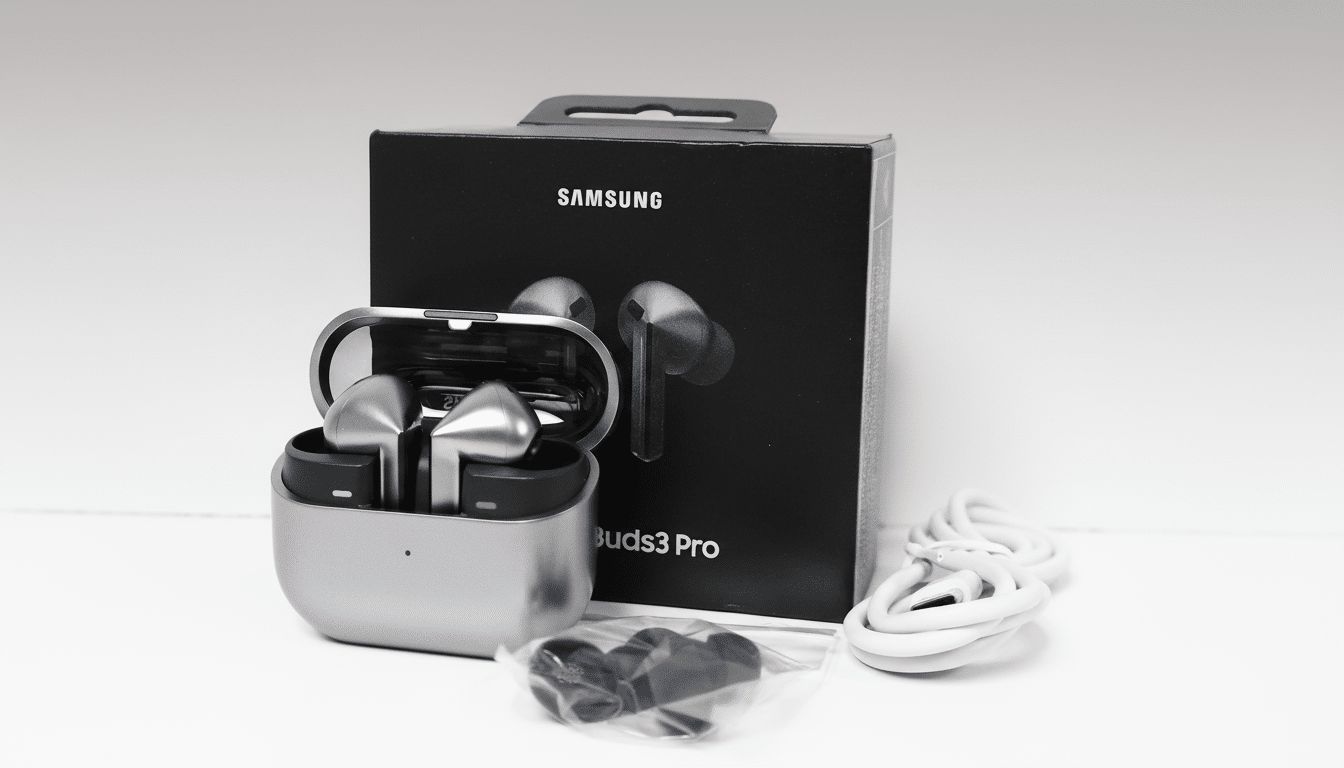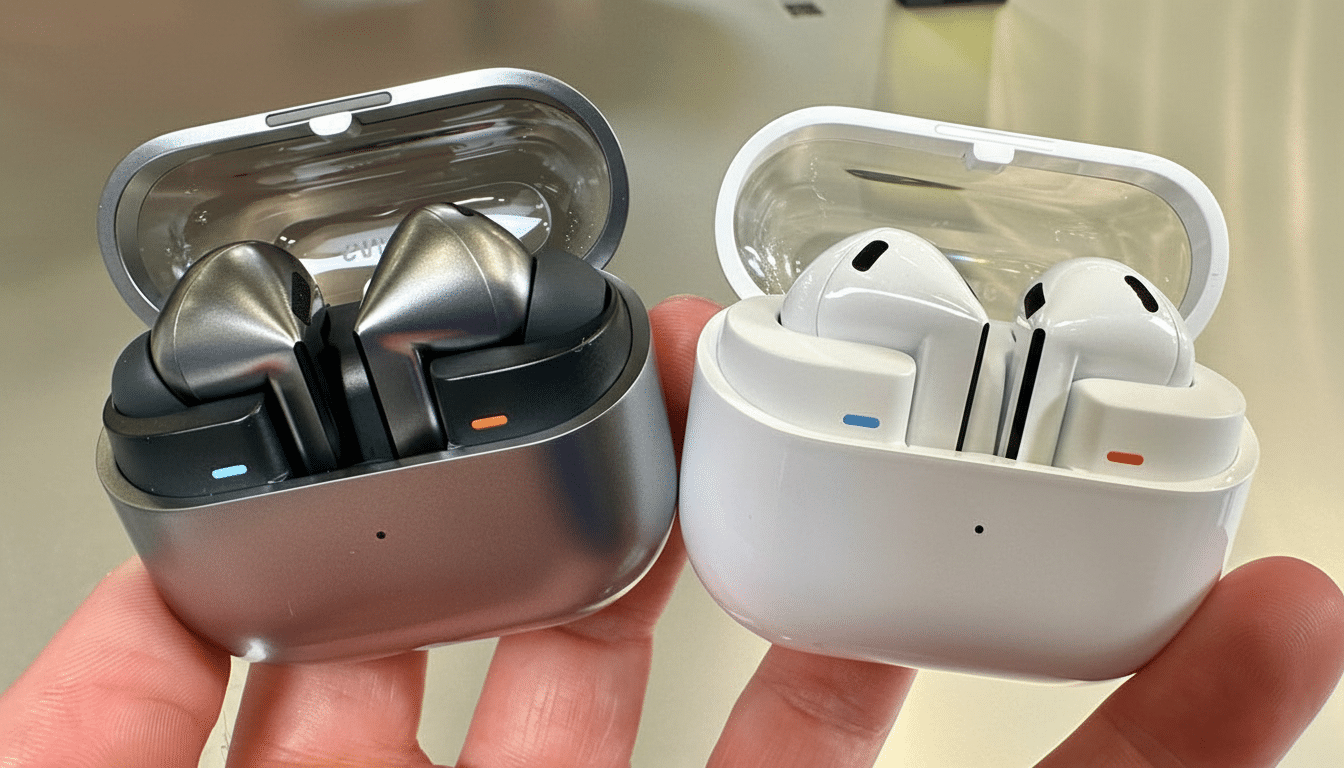I put on Apple’s AirPods Pro 3 and Samsung’s Galaxy Buds 3 Pro for flights, workouts, office calls and my daily train ride to find out. Each relies heavily on its ecosystem, and each feels flagship, but they’re not masters of the same things. And so after weeks of alternating between an iPhone, a Galaxy phone and a laptop, it’s clear which is the overall victor — though the “best” depends on your device at the end.
Design and comfort compared for fit, seal and daily wear
Both pairs use silicone tips and featherlight shells for a sure, all-day fit, and both are rated as IP57 dust- and water-resistant on the buds — good for runs in the rain or high-intensity gym sessions. Apple’s stems are slightly longer and easier to grip for quick adjustments, while Samsung’s low-profile stem sits just a hair more flush.
- Design and comfort compared for fit, seal and daily wear
- Sound quality and customization: tuning, EQ and balance
- Noise cancellation and transparency in travel and offices
- Smart features and ecosystem perks across Apple and Galaxy
- Battery life and durability ratings for workouts and travel
- Call quality and connectivity, Bluetooth versions and handoff
- Verdict: which earbuds win depends on your device ecosystem

A good seal is important for bass and noise canceling, and both brands package fit tests that guide you through picking the right size tip. During a workday, I found no hot spots from either; Apple’s clamping force was slightly more gentle, giving it the slightest edge in comfort over long listening sessions.
Sound quality and customization: tuning, EQ and balance
Out of the box, AirPods Pro 3 tipped toward balance: clear mids, treble that is natural, and bass that is present but not wobbly. The Galaxy Buds 3 Pro hit harder down low and come across more club-tuned by default. If you’re into shaping your sig, Samsung gives you a nine-band EQ (63Hz to 16kHz) as well as some handy presets. Apple effectively tells you to “trust our tuning,” adding only a pinprick of user EQ — this is fine if you like a reference-leaning curve.
Eclectic with one C (playlists): The Buds’ deeper sub-bass felt more cinematic on pop, jazz, podcasts and EDM, while the AirPods presented vocals and acoustic instruments with a firmer grip on timbral realism. For tinkerers and bassheads, Samsung wins. For lifelike balance, Apple does.
Noise cancellation and transparency in travel and offices
Both offer strong active noise cancellation (ANC) and adaptive modes that respond to your environment. In a jet cabin, AirPods Pro 3 cut out engine rumble slightly more evenly, and their Transparency Mode was startlingly natural — voices were distinct without sounding hissy. The Buds 3 Pro block plenty in the low end and with office hum, transparency had a weak sort of processing sheen at times.
Many lab tests, including those through such outlets as Consumer Reports, still find that Bose sets the ANC benchmark.
But between these two? Apple has the more convincing combination of ANC intensity and transparent pass-through.

Smart features and ecosystem perks across Apple and Galaxy
Apple rigs the deck if you live in its world. Automatic Switching effortlessly bounces between your iPhone, iPad and Mac. Spatial Audio provides immersive staging for movies and some music. Live Translation on the iPhone can even translate speech in real time into your ear. The most eye-catching addition is an in-ear heart rate monitor that sends data back to Apple Fitness, and it pairs with the AI-driven Workout Buddy coaching feature — turning earbuds into a stealth health tracker.
Samsung largely mirrors that for Galaxy users: instant pairing, Auto Switch across Galaxy devices, and 360 Audio if you watch video on a device; an Interpreter feature that provides hearing enhancements. You will have the whole suite on a Samsung phone, though most Android users get a rich array of features. If your tech life is rooted in Galaxy, these buds feel native in all the right ways.
On the health front: Peer-reviewed research from studies by IEEE and the Journal of Biomedical Optics has proven that in-ear PPG can successfully track heart rate with robust accuracy during steady-state activities, adding plausibility to Apple’s sensor for everyday training. Like any other, it’s not a medical device or anything like that.
Battery life and durability ratings for workouts and travel
Battery life is a spec win for Apple, period: up to 8 hours from the buds (24 with the case) versus Samsung’s 6 and 20. On a coast-to-coast flight, the AirPods ended up with some juice left over, while the Buds pushed me to consider a top-up before landing. Both cases are pocketable and durable, and both earbuds share the same IP57 rating for workouts and weather.
Call quality and connectivity, Bluetooth versions and handoff
For calls, beamforming mics on both were capable of conference rooms and sidewalks, with Apple winning in wind reduction against Samsung. Bluetooth is rock-solid on both; AirPods Pro 3 use Bluetooth 5.3, while Galaxy Buds 3 Pro bump up to 5.4. The more interesting question is ecosystem handoff: Apple’s Auto Switching is excellent across iCloud devices, Samsung’s best across Galaxy phones, tablets and watches.
Verdict: which earbuds win depends on your device ecosystem
On iPhone, AirPods Pro 3 are a no-brainer. They outlast rivals, cancel more consistently, and do so with the most lifelike transparency; plus they pile on your choice of worthwhile health and translation features that you’ll actually use. Galaxy or Android users seeking a tailored sound that’s heavy-hitting in the bass and serious about EQ fine-tuning will find plenty to like in the Galaxy Buds 3 Pro — and as a pair, these buds have finally become best mates with a Samsung phone.
Overall winner: AirPods Pro 3. They have the best mix of sound, ANC, battery life and genuinely helpful intelligence. The Galaxy Buds 3 Pro are the runner-up, providing worthwhile tuning control and a stronger low end for Android loyalists.

